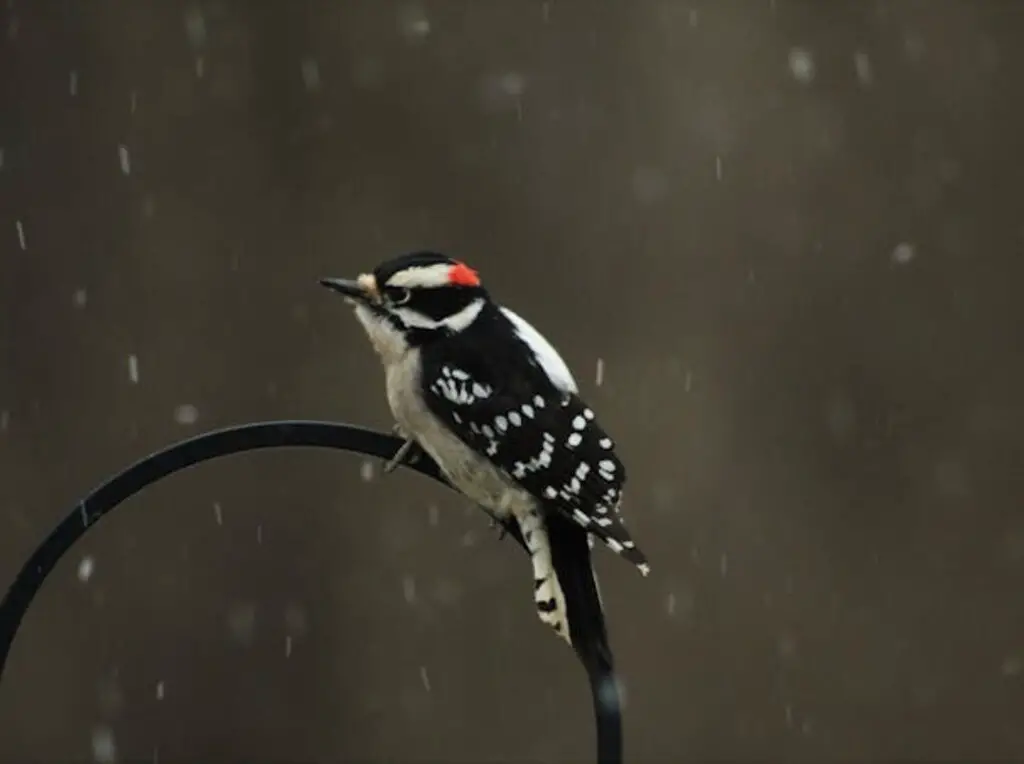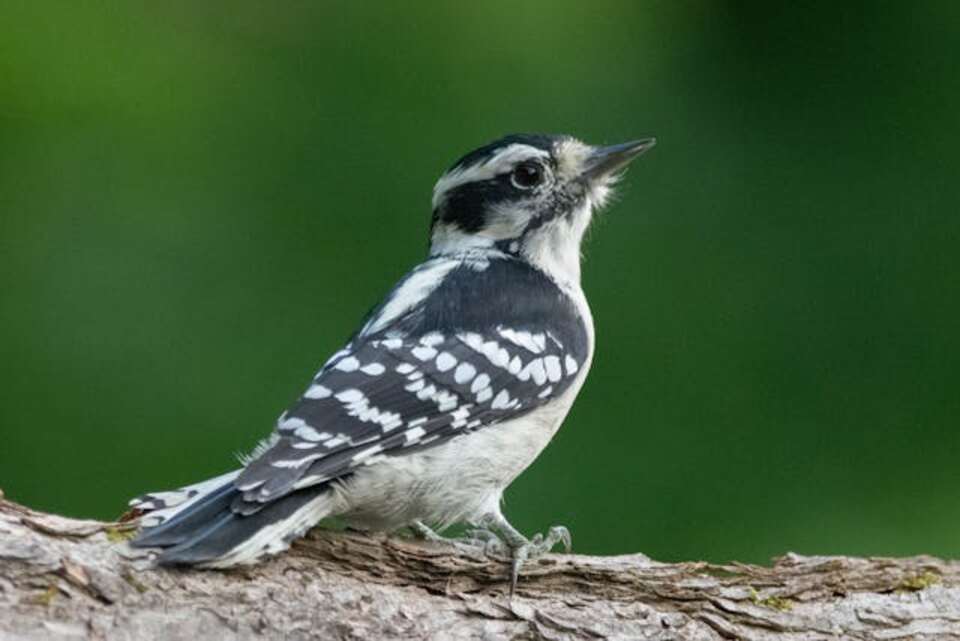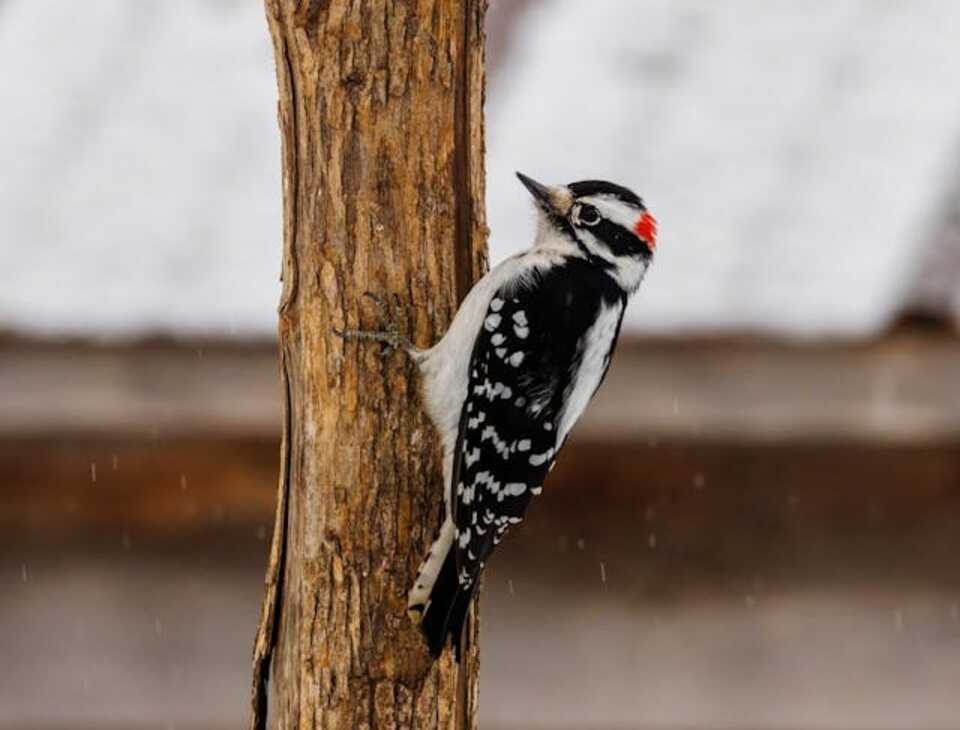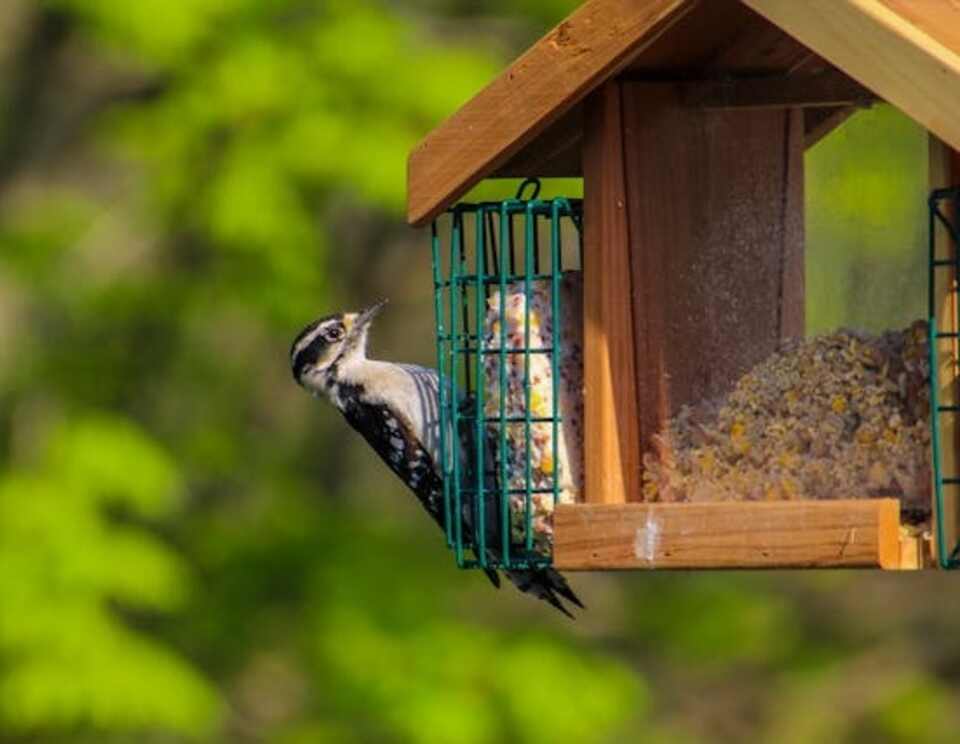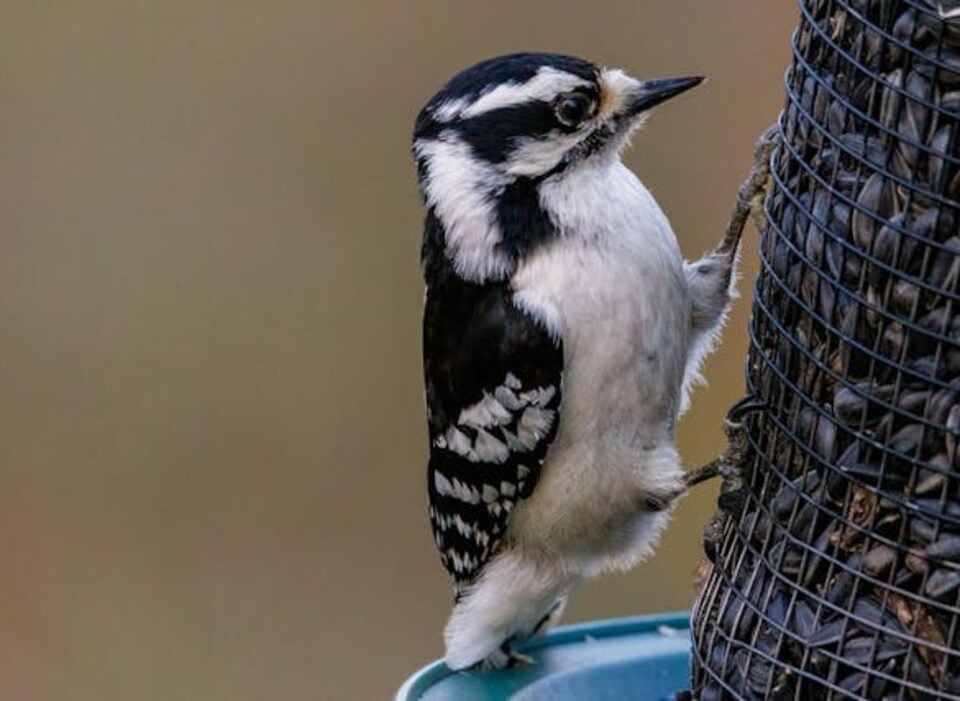The first time I spotted a Downy Woodpecker, it was clinging to a suet feeder just outside my kitchen window. Its tiny frame and bold black-and-white pattern instantly caught my eye, and from that moment, I was hooked.
The Downy Woodpecker is more than just a common backyard bird, it’s a symbol of how nature thrives right outside our doors. As North America’s smallest woodpecker, it’s known for its friendly demeanor, acrobatic foraging, and high-pitched “pik” calls. Whether you’re a beginner birder or a seasoned watcher, the Downy offers a fun and easy species to observe year-round.
✅ Fun Fact: Males and females feed on different parts of trees to reduce competition, males tend to forage on thinner branches, while females prefer thicker trunks.
Table of Contents
- 1 Physical Traits: Black and White Differences
- 2 Downy vs. Hairy Woodpecker Comparison
- 3 Habitat: From Forests to Backyards
- 4 Diet: A Varied and Opportunistic Menu
- 5 How to Attract Downy Woodpeckers
- 6 Behavior: Daily Life of a Downy Woodpecker
- 7 Reproduction: From Courtship to Fledging
- 8 Conservation Status: Challenges & Actions
- 9 Downy Woodpeckers in Culture and History
- 10 Conclusion
- 11 Author
Physical Traits: Black and White Differences
The Downy Woodpecker (Dryobates pubescens) is a study in contrasts, its plumage a striking pattern of black and white that makes it easily recognizable even to novice birdwatchers. Let’s take a closer look at the physical attributes that define this charming species:
Size and Shape:
- Length: 5.5 to 6.7 inches (14 to 17 cm)
- Wingspan: 9.8 to 11.8 inches (25 to 30 cm)
- Weight: 0.7 to 1.0 ounces (20 to 28 grams)
The Downy Woodpecker is the smallest woodpecker species in North America, with a compact, cylindrical body typical of its family. Its small size distinguishes it from its larger lookalike, the Hairy Woodpecker.
Plumage: The Downy Woodpecker’s plumage is a striking black and white pattern:
- Back: Black with a broad white stripe down the center
- Wings: Black with white spots forming wing bars
- Head: Black with white stripes above and below the eyes
- Underparts: White to grayish-white
Sexual Dimorphism: While male and female Downy Woodpeckers share similar overall plumage, there is one key difference:
- Males: Small red patch on the back of the head
- Females: Lack the red patch, with the entire head being black and white
Bill: The bill of the Downy Woodpecker is another distinguishing feature:
- Length: About half the length of the head
- Shape: Straight, chisel-like
- Color: Dark gray to black
This relatively short bill sets it apart from the similar-looking Hairy Woodpecker, whose bill is nearly as long as its head.
Feet and Legs: Like all woodpeckers, the Downy has specialized feet adapted for clinging to vertical surfaces:
- Arrangement: Two toes pointing forward, two pointing backward (zygodactyl arrangement)
- Color: Grayish to blue-gray
Eyes:
- Color: Dark brown
- Position: Set on the sides of the head, providing excellent peripheral vision
Downy vs. Hairy Woodpecker Comparison
| Feature | Downy Woodpecker | Hairy Woodpecker |
|---|---|---|
| Scientific Name | Dryobates pubescens | Dryobates villosus |
| Size | 5.5 – 6.7 in (14 – 17 cm) | 7.1 – 10.2 in (18 – 26 cm) |
| Wingspan | 9.8 – 11.8 in (25 – 30 cm) | 13.0 – 16.1 in (33 – 41 cm) |
| Bill Size | Short, about half the length of the head | Long, nearly equal to head length |
| Plumage Pattern | Black and white, white back stripe, spotted wings | Similar pattern, but cleaner and bolder |
| Head Markings (Male) | Small red patch on the back of the head | Larger red patch on back of the head |
| Outer Tail Feathers | Usually show black spots | Pure white, no spots |
| Call | Soft, high-pitched “pik” | Louder, sharper “peek” |
| Drumming | Slower and softer | Louder and more forceful |
| Habitat Preference | More adaptable; frequent in suburban yards | Prefers mature forests; less common in urban areas |
| Feeder Visits | Very common | Occasional visitor |
| Behavior | Often tamer and less wary of humans | More cautious and less likely to visit feeders |
Habitat: From Forests to Backyards
The Downy Woodpecker is a highly adaptable species, found across a wide range of habitats throughout North America. Its ability to thrive in diverse environments contributes significantly to its widespread distribution and relative abundance.
Primary Habitats:
- Deciduous Forests: Particularly fond of oak, maple, and beech woodlands
- Mixed Forests: Areas with a combination of deciduous and coniferous trees
- Riparian Zones: Wooded areas along rivers, streams, and lakes
- Open Woodlands: Parklike settings with scattered trees
- Suburban Areas: Parks, gardens, and neighborhoods with mature trees
Habitat Requirements: While adaptable, Downy Woodpeckers do have some specific habitat needs:
- Dead or Dying Trees: Essential for nesting and foraging
- Diverse Tree Species: Provides a variety of food sources throughout the year
- Understory Vegetation: Offers additional foraging opportunities and cover
Geographic Distribution: The Downy Woodpecker’s range extends across North America:
- Northern Limit: Southern Alaska and northern Canada
- Southern Limit: Southern California, Florida, and parts of Mexico
- Eastern Limit: Atlantic Coast
- Western Limit: Pacific Coast
Altitudinal Range: Downy Woodpeckers can be found from sea level up to elevations of about 9,000 feet (2,750 meters) in some parts of their range, showing remarkable adaptability to different climatic conditions.
Urban Adaptation: One of the most notable aspects of the Downy Woodpecker’s habitat preferences is its successful adaptation to urban and suburban environments. This adaptability has several implications:
- Increased visibility and popularity among backyard birdwatchers
- Potential for human-wildlife conflicts (e.g., damage to wooden structures)
- Opportunities for citizen science and conservation efforts
Diet: A Varied and Opportunistic Menu
The Downy Woodpecker’s diet is as diverse as its habitat preferences, reflecting both its adaptability and its important role in ecosystem health. These small birds are primarily insectivorous but display remarkable flexibility in their feeding habits throughout the year.
Primary Food Sources:
- Insects: The mainstay of the Downy Woodpecker’s diet
- Wood-boring beetle larvae
- Ants
- Caterpillars
- Bark beetles
- Weevils
- Spiders
- Plant Material:
- Seeds (especially in winter)
- Berries
- Nuts
- Tree sap
- Human-provided Food:
- Suet
- Black oil sunflower seeds
- Peanuts
Seasonal Dietary Shifts: The Downy Woodpecker’s diet changes with the seasons, reflecting food availability:
| Season | Primary Diet | Notes |
|---|---|---|
| Spring | Insects | Focus on protein-rich foods for breeding season |
| Summer | Insects | Abundance of insect prey |
| Fall | Insects and Seeds | Transition to more plant-based diet |
| Winter | Seeds and Suet | Reliance on high-energy foods to survive cold |
Foraging Techniques: Downy Woodpeckers employ a variety of foraging strategies to access their diverse diet:
- Gleaning: Picking insects from bark surfaces
- Probing: Using their bill to explore cracks and crevices in bark
- Drilling: Creating holes in wood to access insect larvae
- Sapsucking: Occasionally drinking sap from wells created by sapsuckers
- Ground Foraging: Searching for insects in fallen logs or on the forest floor
- Flycatching: Occasionally catching insects in flight
Ecological Impact: The Downy Woodpecker’s feeding habits have significant ecological implications:
- Pest Control: Help control populations of potentially harmful insects
- Seed Dispersal: Contribute to forest regeneration by spreading seeds
- Ecosystem Engineers: Create habitat for other species through their foraging activities
Adaptations for Feeding: Several physical and behavioral adaptations aid the Downy Woodpecker in its foraging:
- Strong, chisel-like bill for drilling into wood
- Long, barbed tongue for extracting insects from bark crevices
- Stiff tail feathers for support while climbing and foraging on vertical surfaces
- Excellent spatial memory for relocating productive foraging sites
Understanding the Downy Woodpecker’s diet not only provides insight into the species’ ecology but also offers valuable information for attracting these charming birds to backyard feeders, contributing to both conservation efforts and the enjoyment of birdwatchers.
How to Attract Downy Woodpeckers
Attracting Downy Woodpeckers to your backyard can be a rewarding experience for birdwatchers. These charming birds are drawn to environments that mimic their natural habitats—forests with trees and open spaces. Here are some simple tips to make your yard more appealing to Downy Woodpeckers:
- Provide Suet Feeders: Downy Woodpeckers love suet, especially in the colder months. A suet feeder, placed near trees or shrubs, will attract them with its high-fat content.
- Offer Birdseed: While Downy Woodpeckers prefer insects and tree sap, they will also visit bird feeders with sunflower seeds and peanuts. Consider offering a mix that includes these.
- Create the Right Habitat: These woodpeckers prefer areas with mature trees and deadwood. If possible, leave some trees with exposed bark or dead branches in your yard, as they love foraging for insects in these areas.
- Install a Bird Bath: Like many birds, Downy Woodpeckers need water for drinking and bathing. A shallow bird bath can encourage them to stop by, especially during dry spells.
- Add Nesting Sites: Providing nesting boxes can also attract Downy Woodpeckers during the breeding season. Ensure the box is installed on a tree, around 10–15 feet off the ground, and has a hole small enough to keep out larger birds.
By making your yard more inviting with these tips, you’ll increase the chances of seeing Downy Woodpeckers up close and enjoy their fascinating behavior.
Behavior: Daily Life of a Downy Woodpecker
The Downy Woodpecker’s behavior is a fascinating blend of industriousness, adaptability, and social interaction. Understanding these behaviors not only provides insight into the species’ ecology but also enhances the experience of observing these charismatic birds in the wild.
Daily Activity Pattern: Downy Woodpeckers are diurnal, with their daily routines typically following this pattern:
- Dawn: Begin the day with vocal communications and territorial drumming
- Morning: Peak foraging activity
- Midday: Reduced activity, possibly resting or preening
- Afternoon: Second peak of foraging activity
- Evening: Return to roosting sites as light fades
Movement and Flight:
- Climbing: Adept at moving up, down, and sideways on tree trunks and branches
- Flight: Undulating flight pattern typical of woodpeckers, with periods of flapping interspersed with brief glides
- Home Range: Typically 5-25 acres, depending on habitat quality and season
Vocalizations: Downy Woodpeckers have a variety of vocalizations serving different purposes:
- Pik Call: A sharp, high-pitched sound used for general communication
- Whinny Call: A descending, whinny-like trill often used to announce presence or as an alarm
- Drumming: Rapid pecking on resonant surfaces for territorial communication and mate attraction
Social Behavior: While generally solitary, Downy Woodpeckers exhibit interesting social behaviors:
- Pair Bonding: Form monogamous pairs during breeding season
- Winter Flocking: May join mixed-species flocks in winter for improved foraging efficiency and predator detection
- Territorial Behavior: Defend territories year-round, with increased aggression during breeding season
Interspecific Interactions: Downy Woodpeckers interact with various other species:
- Competition: May compete with Hairy Woodpeckers and other cavity-nesting birds for nesting sites
- Cooperation: Often seen foraging alongside chickadees, nuthatches, and titmice in mixed flocks
- Predator Avoidance: Alert to threats from hawks, owls, and occasionally domestic cats
Intelligence and Learning: Recent studies have highlighted the cognitive abilities of Downy Woodpeckers:
- Problem-Solving: Demonstrate ability to learn and remember the locations of productive foraging sites
- Tool Use: While not as pronounced as in some other woodpecker species, Downys have been observed using bark flakes as tools to pry off loose bark
Adaptations to Human Environments: Downy Woodpeckers have shown remarkable adaptability to human-altered landscapes:
- Feeder Use: Quickly learn to use bird feeders, particularly those offering suet or sunflower seeds
- Nesting in Structures: May occasionally nest in wooden buildings or nest boxes
- Urban Noise Adaptation: Some evidence suggests they may alter their drumming patterns in noisy urban environments
Understanding these behavioral traits not only enriches our appreciation of the Downy Woodpecker but also informs conservation strategies and backyard birdwatching practices.
Reproduction: From Courtship to Fledging
The reproductive cycle of the Downy Woodpecker is a crucial aspect of its life history, involving elaborate courtship rituals, cooperative nesting behaviors, and dedicated parental care. Let’s explore the various stages of this process:
Breeding Season:
- Timing: Typically begins in late winter or early spring, varying by latitude
- Duration: Generally lasts from April to June in most of their range
Courtship: Downy Woodpeckers engage in several courtship behaviors:
- Drumming Displays: Males drum on resonant surfaces to attract females and establish territories
- Visual Displays: Include bill raising, head swinging, and wing spreading
- Chase Flights: Pairs engage in spiraling flights around tree trunks
- Mutual Tapping: Potential mates tap on opposite sides of a branch, possibly as a form of pair bonding
Nest Site Selection:
- Location: Dead or dying trees, or dead parts of live trees
- Height: Typically 8 to 50 feet above ground
- Preferred Trees: Deciduous species like aspen, birch, or maple
- Cavity Characteristics:
- Entrance Hole: Circular, about 1-1.5 inches in diameter
- Cavity Depth: 6 to 12 inches
Nest Building:
- Process: Both male and female excavate the cavity, taking 1-3 weeks
- Division of Labor: Male often does more of the excavation work
- Timing: New cavity usually excavated each year, though old ones may be reused
Egg Laying and Incubation:
- Clutch Size: 3-6 eggs, typically 4
- Egg Characteristics: White, smooth, and slightly glossy
- Incubation Period: 12 days on average
- Incubation Duties: Shared by both parents, with males often incubating at night
Nestling Care:
- Hatchling Characteristics: Altricial (helpless at birth), naked, and blind
- Feeding: Both parents feed the young, regurgitating insects
- Nestling Period: 18-21 days
- Fledging: Young leave the nest but stay near parents for several weeks
Reproductive Success:
- Number of Broods: Usually one per year, occasionally two in southern regions
- Fledging Success Rate: Varies, but typically 2-4 young fledge per successful nest
- Threats: Predation by snakes, raccoons, and competing cavity-nesters
Parental Care:
- Duration: Parents continue to feed and protect fledglings for 3-6 weeks after leaving the nest
- Training: Adults teach foraging techniques to young birds
Understanding the reproductive cycle of the Downy Woodpecker is crucial for conservation efforts, as it highlights the importance of preserving suitable nesting habitats and the timing of critical life stages.
Conservation Status: Challenges & Actions
The Downy Woodpecker, while currently abundant across much of its range, faces both challenges and opportunities in the changing North American landscape. Understanding its conservation status is crucial for ensuring the long-term survival of this charismatic species.
Current Population Status:
- Global Population Estimate: 14 million individuals
- Population Trend: Generally stable, with some regional fluctuations
- IUCN Red List Status: Least Concern
Threats: Despite their stable population, Downy Woodpeckers face several threats:
- Habitat Loss: Urbanization and deforestation reduce available nesting and foraging sites
- Climate Change: Altering vegetation patterns and insect prey availability
- Pesticide Use: Reduces insect prey and may cause direct poisoning
- Window Collisions: A significant source of mortality in urban and suburban areas
- Competition: Increased competition with European Starlings and other cavity-nesters for nesting sites
Conservation Efforts: Several initiatives are underway to protect Downy Woodpeckers and their habitats:
- Habitat Preservation: Protection of mature forests and woodland areas
- Urban Greening: Planting of native trees in urban and suburban areas
- Nestbox Programs: Provision of artificial nesting sites in areas lacking natural cavities
- Citizen Science: Engagement of the public in monitoring programs like the Christmas Bird Count
- Pesticide Reduction: Promotion of integrated pest management practices
Legal Protections:
- Migratory Bird Treaty Act: Protects Downy Woodpeckers and their nests in the United States
- Similar protections exist in Canada under the Migratory Birds Convention Act
Role in Ecosystem Health: Conserving Downy Woodpeckers has broader ecological benefits:
- Pest Control: Help control populations of potentially harmful forest insects
- Cavity Creation: Excavate cavities used by numerous other species
- Indicator Species: Their presence can indicate overall forest health
Future Outlook: While the current conservation status of the Downy Woodpecker is favorable, continued monitoring and conservation efforts are crucial. Climate change, in particular, may pose significant challenges in the coming decades, potentially altering the species’ range and habitat availability.
How You Can Help: Individual actions can contribute to Downy Woodpecker conservation:
- Maintain dead trees (where safe) to provide nesting sites
- Plant native tree species in your yard
- Provide suet feeders, especially in winter
- Participate in citizen science projects monitoring woodpecker populations
- Support conservation organizations working to protect forest habitats
By understanding and addressing the conservation needs of the Downy Woodpecker, we not only help ensure the future of this beloved species but also contribute to the health of entire forest ecosystems.
Downy Woodpeckers in Culture and History
The Downy Woodpecker, with its striking appearance and familiar presence in both wild and urban settings, has left its mark on human culture and history. From indigenous folklore to modern-day symbolism, these small but charismatic birds have captured our imagination in various ways.
Indigenous Folklore: Many Native American tribes incorporated woodpeckers, including the Downy, into their legends and beliefs:
- Cherokee: Woodpeckers were seen as symbols of determination and perseverance
- Ojibwe: Believed woodpeckers had the power to summon rain
- Some tribes used woodpecker feathers in ceremonial dress and rituals
Early Naturalists:
- John James Audubon: Included detailed observations and illustrations of the Downy Woodpecker in his seminal work “The Birds of America”
- Alexander Wilson: Provided some of the earliest scientific descriptions of Downy Woodpecker behavior in his “American Ornithology”
Popular Culture: While not as prominent as some other bird species, Downy Woodpeckers have made appearances in various forms of media:
- Children’s Literature: Featured in numerous nature-themed books for young readers
- Nature Documentaries: Often highlighted as an example of woodland biodiversity
- Birdwatching Culture: A favorite among backyard birdwatchers due to their frequent visits to feeders
Symbolic Meanings: In various contexts, Downy Woodpeckers have come to symbolize:
- Industriousness and persistence
- Ability to find nourishment in unlikely places
- Rhythm and communication (due to their drumming behavior)
- Adaptability to changing environments
Scientific Impact: Research on Downy Woodpeckers has contributed to several areas of scientific understanding:
- Forest Ecology: Studies on their foraging habits have informed forest management practices
- Avian Biology: Their well-studied drumming behavior has provided insights into bird communication
- Urban Ecology: Research on their adaptation to human environments has informed urban wildlife management
Conservation Mascot: While not officially designated as such, Downy Woodpeckers often serve as unofficial mascots for:
- Forest conservation efforts
- Backyard wildlife habitat initiatives
- Citizen science projects focused on urban biodiversity
Economic Importance: Downy Woodpeckers play a role in local economies:
- Birdwatching Industry: Attract birdwatchers, contributing to ecotourism
- Pest Control: Their insectivorous diet helps control forest and garden pests
- Bird Feeding Market: Their popularity drives sales of suet and specialized feeders
Understanding the cultural significance of the Downy Woodpecker adds depth to our appreciation of this species. It reminds us that conservation is not just about preserving biodiversity, but also about maintaining the rich tapestry of human-nature interactions that have shaped our cultures and histories.
Conclusion
As we’ve explored throughout this comprehensive guide, the Downy Woodpecker is far more than just a small black and white bird that visits our feeders. It’s a species that embodies resilience, adaptability, and the intricate connections within forest ecosystems.
From its striking plumage and specialized physical adaptations to its complex behaviors and important ecological role, the Downy Woodpecker continues to fascinate scientists, nature enthusiasts, and casual observers alike. Its ability to thrive in diverse habitats, from pristine forests to urban parks, makes it a unique ambassador for wildlife in our changing world.
The conservation status of the Downy Woodpecker, while currently stable, reminds us of the ongoing need for habitat preservation and thoughtful environmental stewardship. As we face challenges like climate change and urbanization, the adaptability of species like the Downy Woodpecker offers both hope and valuable lessons.
For many of us, the sight of a Downy Woodpecker industriously foraging on a tree trunk or visiting a backyard feeder brings a moment of connection with the natural world. It’s a reminder of the diversity of life that surrounds us, often hidden in plain sight.
As we move forward, let us continue to observe, study, and appreciate the Downy Woodpecker. Whether through scientific research, conservation efforts, or simply maintaining bird-friendly spaces in our own backyards, we all have a role to play in ensuring that future generations can experience the joy of encountering these remarkable birds.
The story of the Downy Woodpecker is, in many ways, our own story – one of adaptation, resilience, and the enduring bonds between species and their environments. By understanding and protecting these tiny carpenters of the forest, we not only secure their future but also enrich our own lives and the health of the ecosystems we all share.

